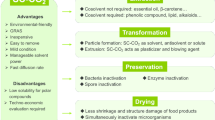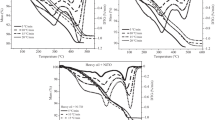Abstract
The current work deals with the process intensification of esterification reaction via ultrasonic (US) and microwave (MW) irradiations using the cheapest feedstock, such as Palm Fatty Acid Distillate (PFAD). Systematic studies have been done by conventional methods to find the optimum parameters, such as molar ratio of PFAD to methanol, temperature, type of catalyst, and catalyst loading. In order to enhance the rate of reaction, experiments were carried out using approaches based on ultrasound and microwave irradiations at optimal parameters obtained from the conventional approach. Significant enhancement in extent of equilibrium conversion and rate of reaction is observed in the presence of microwave irradiation than any other method used in the current study. The maximum reduction in acid value obtained using MW irradiation, US irradiation, and conventional approaches was 98.8% (for 25 min of reaction time), 97.8% (for 150 min of reaction time), and 97.6% (for 180 min of reaction time), respectively. The kinetic rate constants (activation energy) for the reaction using MW irradiation, US irradiation, and conventional approach were 0.7089 (9.6 × 104 kJ/mg), 0.2063 (1.7 × 105 kJ/mg), and 0.1629 (2.1 × 105 kJ/mg) l/mol/min, respectively.









Similar content being viewed by others
Abbreviations
- PFAD:
-
Palm fatty acid distillate
- US:
-
Ultrasound
- wt%:
-
Weight percent
- MW:
-
Microwave
- [A]:
-
Final concentration of free fatty acid, mol/l
- [A]0 :
-
Final concentration of free fatty acid, mol/l
- k :
-
Second-order rate constant, l/mol/min
- m :
-
Mass of reaction mixture, kg
- C p :
-
Specific heat, J/kg K
- ∆T :
-
Change in temperature, K
- kJ:
-
Kilojoules
- mg:
-
Milligram
- J:
-
Joule
- FFA:
-
Free fatty acid
References
Canakci M, Gerpen V (2001) Biodiesel production from oils and fats with high free fatty acids. Trans ASAE 44:1429–1436. https://doi.org/10.13031/2013.7010
Cerdán L, Medina A, Giménez A, González M, Grima E (1998) Synthesis of polyunsaturated fatty acid-enriched triglycerides by lipase-catalyzed esterification. J Am Oil Chem Soc 75:1329–1337. https://doi.org/10.1007/s11746-998-0180-y
Corro G, Tellez N, Banuelos F, Mendoza M (2012) Biodiesel from Jatrophacurcas oil using Zn for esterification step and solar radiation as energy source. Fuel 97:72–79. https://doi.org/10.1016/j.fuel.2012.02.029
Deshmane V, Gogate P, Pandit A (2009) Ultrasound assisted synthesis of isopropyl esters from palm fatty acid distillate. Ultrason Sonochem 16:345–350. https://doi.org/10.1016/j.ultsonch.2008.09.004
Dias J, Alvim-Ferrazand M, Almeida M (2009) Production of biodiesel from acid waste lard. J Bioresour Technol 100:6355–6361. https://doi.org/10.1016/j.biortech.2009.07.025
Dubey S, Gole V, Gogate P (2015) Cavitation assisted synthesis of fatty acid methyl esters from sustainable feedstock in presence of heterogeneous catalyst using two step processes. Ultrason Sonochem 23:165–173. https://doi.org/10.1016/j.ultsonch.2014.08.019
Ferdous K, Rakib Uddin M, Rahim Uddin M, Maksudur R, Khan M, Islam M (2013) Preparation and optimization of biodiesel production from mixed feedstock oil. Chem Eng Sci 4:62–66. https://doi.org/10.12691/ces-1-4-3
Gaikwad N, Gogate P (2015) Synthesis and application of carbon based heterogeneous catalysts for ultrasound assisted biodiesel production. Green Process Synth 4:17–30. https://doi.org/10.1515/gps-2014-0079
Gerpen J, Shanks B, Pruszko R, Clements D, Knothe G (2004) Biodiesel production technology. National Renewable Energy Laboratory, Colorado, pp 52–55. https://www.nrel.gov/docs/fy04osti/36240
Gole V, Gogate P (2012) Intensification synthesis of biodiesel from nonedible oils using sonochemical reactors. Ind Eng Chem Res 51:11866–11874. https://doi.org/10.1021/ie2029442
Gole V, Gogate P (2014) Intensification of glycerolysis reaction of higher free fatty acid containing sustainable feedstock using microwave irradiation. Fuel Process Technol 118:110–116. https://doi.org/10.1016/j.fuproc.2013.08.018
Gole V, Naveen K, Gogate P (2013) Hydrodynamic cavitation as an efficient approach for intensification of synthesis of methyl esters from sustainable feedstock. Chem Eng Process Process Intens 71:70–76. https://doi.org/10.1016/j.cep.2012.10.006
Guan G, Kusakabe K, Yamasaki S (2009) Tri-potassium phosphate as a solid catalyst for biodiesel production from waste cooking oil. Fuel Process Technol 90:520–524. https://doi.org/10.1016/j.fuproc.2009.01.008
Guo J, Sun S, Liu J (2020) Conversion of waste frying palm oil into biodiesel using free lipase A from candida antarctica as a novel catalyst. Fuel 267:117323–117331. https://doi.org/10.1016/j.fuel.2020.117323
Gupta A, Rathod V (2019) Solar radiation as a renewable energy source for the biodiesel production by esterification of palm fatty acid distillate. Energy 182:795–801. https://doi.org/10.1016/j.energy.2019.05.189
Hafizah Arbain N, Salimon J (2011) The effects of various acid catalyst on the esterification of jatropha curcas oil based trimethylolpropane ester as biolubricant base stock. E-J Chem 8:S33–S40. https://doi.org/10.1155/2011/789374
Kelkar M, Gogate P, Pandit A (2008) Intensification of esterification of acids for synthesis of biodiesel using acoustic and hydrodynamic cavitation. Ultrason Sonochem 15:188–194. https://doi.org/10.1016/j.ultsonch.2007.04.003
Maddikeri G, Gogate P, Pandit A (2014) Intensified synthesis of biodiesel using hydrodynamic cavitation reactors based on the interesterification of waste cooking oil. Fuel 137:285–292. https://doi.org/10.1016/j.fuel.2014.08.013
Marchetti J, Miguel V, Errazu A (2007) Heterogeneous esterification of oil with high amount of free fatty acids. J Fuel 86:906–910. https://doi.org/10.1016/j.fuel.2006.09.006
Metre A, Nath K (2015) Super phosphoric acid catalyzed esterification of Palm Fatty Acid Distillate for biodiesel production: physicochemical parameters and kinetics. Pol J Chem Technol 17:88–96. https://doi.org/10.1515/pjct-2015-0013
Mohod A, Subudhi A, Gogate P (2017) Intensification of esterification of non edible oil as sustainable feedstock using cavitational reactors. Ultrason Sonochem 36:309–318. https://doi.org/10.1016/j.ultsonch.2016.11.040
Mostafa N, Maher A, Delmoez W (2013) Production of mono-, di-, and triglycerides from waste fatty acids through esterification with glycerol. Adv Biosci Biotechnol 4:900–907. https://doi.org/10.4236/abb.2013.49118
Ozbay N, Oktar N, Alper Tapan N (2008) Esterification of free fatty acids in waste cooking oils (WCO): role of ion-exchange resins. Fuel 87:1789–1798. https://doi.org/10.1016/j.fuel.2007.12.010
Riaz U, Ashraf S, Madan A (2014) Effect of microwave irradiation time and temperature on the spectroscopic and morphological properties of nano structured poly(carbazole) synthesized within bentonite clay galleries. New J Chem 38:4219–4228. https://doi.org/10.1039/C3NJ01597A
Sharma Y, Sing B (2010) An ideal feedstock, kusum (Schleicheratriguga) for preparation of biodiesel: optimization of parameters. Fuel 89:1470–1474. https://doi.org/10.1016/j.fuel.2009.10.013
Shin J, Kim H, Hong S, Kwon S, Na E, Bae H, Park W, Kang K (2012) Effects of ultrasonification and mechanical stirring methods for the production of biodiesel from rapeseed oil. Korean J Chem Eng 29:460–463. https://doi.org/10.1007/s11814-011-0205-3
Shu Q, Gao J, Nawaz Z, Liao Y, Wang D, Wang J (2010) Synthesis of biodiesel from waste vegetable oil with large amounts of free fatty acids using a carbon-based solid acid catalyst. Appl Energy 87:2589–2596. https://doi.org/10.1016/j.apenergy.2010.03.024
Simasatitkul L, Siricharnasakunchai P, Patcharavorachot Y, Assaburmrungrat S, Arpornwichanop A (2011) Reactive distillation for biodiesel production from soyabean oil. Korean J Chem Eng 28:649–655. https://doi.org/10.1007/s11814-010-0440-z
Tomasevic A, Siler-Marinkovic S (2003) Methanolysis of used frying oil. Fuel Process Technol 81:1–6. https://doi.org/10.1016/S0378-3820(02)00096-6
Yujaroen D, Goto M, Sasaki M, Shotipruk A (2009) Esterification of palm fatty acid distillate (PFAD) in supercritical methanol: effect of hydrolysis on reaction reactivity. Fuel 88:2011–2016. https://doi.org/10.1016/j.fuel.2009.02.040
Zhang Y, Dube M, McLean D, Kates M (2003) Biodiesel production from waste cooking oil: 1. Process design and technological assessment. Bioresour Technol 89:1–16. https://doi.org/10.1016/s0960-8524(03)00040-3
Author information
Authors and Affiliations
Corresponding author
Ethics declarations
Conflict of interest
Authors report no conflicting interests.
Appendix 1
Appendix 1
-
(I)
Determination of energy requirement for esterification using conventional approach
$$\begin{aligned} {\text{Total}}\;{\text{energy}} & = \left( {{\text{Power}}\;{\text{used}}\;{\text{for}}\;{\text{one}}\;{\text{stirrer}} \times {\text{stirring}}\;{\text{times}}\;{\text{in sec}}} \right) + \left( {mcp\Delta T} \right) \\ & \quad + \;{\text{energy}}\;{\text{required}}\;{\text{to}}\;{\text{maintain}}\;{\text{the}}\;{\text{temperature}} \\ & = \left( {1 \, \times \, 120 \, \times \, 180 \times \, 60} \right) \, + \, \left( {0.1 \, \times \, 4.18 \, \times \, 10^{3} \times \, \left( {60 - 40} \right)} \right) \, + \, \left( {120 \, \times \, 150 \, \times \, 60} \right) \\ & = 12, \, 96,000 \, + 8360 + \, 10, \, 80,000 \\ & = 2.3 \, \times \, 10^{6} \;{\text{J}} \\ \end{aligned}$$For 1 g of oil, the observed reduction in the acid value = 11.2 mg.
Energy required for unit reduction = total energy required/net reduction.
= 2.1 × 105 kJ/mg.
-
(II)
Determination of energy requirement using ultrasonic irradiation (for the same conversion)
$$\begin{aligned} {\text{Total}}\;{\text{energy}} & = \left( {mcp\Delta T} \right) + {\text{power}}\;{\text{used}}\;{\text{by}}\;{\text{ultrasonic}}\;{\text{horn}} \\ & = \left( {0.1 \, \times \, 4.18 \, \times \, 10^{3} \times \, \left( {60 - 40} \right)} \right) \, + \, \left( {100 \times \, 150 \times \, 60} \right) \\ & = 8360 \, + \, 10, \, 80,000 \\ & = 1.08 \times \, 10^{6} J \\ \end{aligned}$$For 1 g of oil, the observed reduction in the acid value = 6.06 mg.
Energy required for unit reduction = total energy required/net reduction.
= 1.7 × 105 kJ/mg.
-
(III)
Determination of energy requirement for microwave irradiation
$$\begin{aligned} {\text{Total}}\;{\text{energy}} & = \left( {{\text{Power}}\;{\text{for}}\;{\text{one}}\;{\text{stirrer}} \times {\text{stirring}}\;{\text{times}}\;{\text{in}}\;{\text{sec}}} \right) + \left( {mcp\Delta T} \right) \\ & \quad + {\text{power}}\;{\text{forMW}} \\ & = \left( {1 \, \times \, 120 \, \times \, 25 \times \, 60} \right) \, + \, \left( {0.1 \, \times \, 4.18 \, \times 10^{3} \times \, \left( {60 - 40} \right)} \right) \, + \, \left( {100 \, \times \, 25 \, \times \, 60} \right) \\ & = 1, \, 80,000 \, + \, 8360 \, + \, 1, \, 50,000 \\ & = 3.38 \times \, 10^{5} \;{\text{J}} \\ \end{aligned}$$
For 1 g of oil, the observed reduction in the acid value = 3.5 mg.
Energy required for unit reduction = total energy required/net reduction.
= 9.6 × 104 kJ/mg.
Rights and permissions
About this article
Cite this article
Bagal, M., Deb, B., Unharia, T. et al. Optimization of esterification of palm fatty acid distillate using conventional approach and its comparison with ultrasonic and microwave irradiation. Energ. Ecol. Environ. 6, 555–565 (2021). https://doi.org/10.1007/s40974-021-00206-5
Received:
Revised:
Accepted:
Published:
Issue Date:
DOI: https://doi.org/10.1007/s40974-021-00206-5




